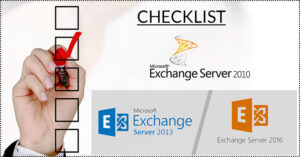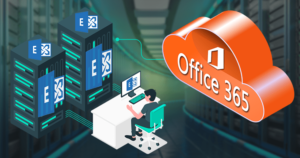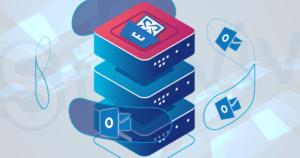Microsoft Exchange Server is among the top-notch platforms that most organizations prefer. Users get various facilities that help them efficiently manage their communication and work collaboratively with their team. Moreover, it offers services from robust email management to advanced calendaring features. This blog will discuss what a Microsoft Exchange account is, its types, and how it works. Also, we will share about the Outlook cached mode and the differences between the On-Premises and Exchange Online.
Let’s understand what is an Exchange account
Microsoft Exchange account is an email account that users use to send and receive emails with the support of the Exchange Server. A Microsoft Exchange account allows users to easily manage their emails, calendars, etc., from a laptop, tablet, or smartphone. Moreover, all users’ account data, such as emails, contacts, calendars, etc., is also stored in the Exchange Server. Users can also collaborate with their team using an Exchange account by sharing sheets, meeting calendars, etc.
How does an Exchange Server account work?
Before understanding how the Microsoft Exchange account works, let us learn about the Exchange Server. Organizations mainly rely on the Exchange Server to manage their emails, contacts, calendars, events, etc. Exchange Server stores all data, such as email messages and other data. When we send an email using an email account, the server first ensures that data is correctly and securely saved. Moreover, users can access their data using IMAP, POP, or Active Sync Exchange Server accounts. Let us understand all of them briefly.
- IMAP (Internet Messaging Access Protocol): An Exchange IMAP account allows users to access emails from an email client, such as Outlook. Using an IMAP account, you read email messages from the server instead of downloading them to your device. Moreover, your email folder items, such as inbox, draft items, and sent items, are with the server.
- POP (Post Office Protocol): When you use a POP account, emails are downloaded from the server to your device. After being stored in the system, the messages are removed from the server. With an Exchange POP account, the emails are directly fetched from the server and stored in your system.
- Active Sync: Users can use an Active Sync account to access Exchange data, such as emails from a laptop, tablet, or smartphone. All data is stored on the server; users only read it using the email client. Moreover, users can access their data when not connected to the internet.
Outlook Cached Mode
Outlook cached mode feature helps users enhance the performance of their Microsoft Outlook when connected to the Exchange Server. This feature allows Outlook to store a copy of all the data (OST file) to the local storage. Moreover, the stored OST file contains emails, calendars, contacts, and other data.
Apart from this, the users can easily access their data even if they do not have a better internet connection. The changes will automatically sync to the server when the user connects to the internet.
Know the functions of the Outlook Cached Mode.
- When the cached mode is enabled, Outlook stores a copy of the entire mailbox into the user’s local drive as the OST file. In case of any interruption, users can easily access their data from this offline database file to work effortlessly.
- Moreover, Outlook’s overall performance enhances, stimulating productivity in the organization.
- Outlook cached mode also helps users improve data synchronization with the Exchange Server.
That’s all how Outlook cached mode helps users in various ways. Moreover, users may face storage issues as the Outlook storage file (OST) holds a lot of data.
Comparison between On-premises and Exchange Online accounts
On-premises Exchange Server Account:
- Using On-premises accounts, all the data is stored and managed on a server at your organization.
- Moreover, it includes various costs to set up an On-premises Exchange Server for the organizations.
- Your IT team or Exchange Admin has complete control of the data and server, which provides better security for the organization’s data from cyber-attacks.
- Organizations can customize their features per their requirements and regulate their communication accordingly.
Exchange Online Account:
- Exchange Online is a part of Microsoft’s Office 365 collaborative platform. Here, you can easily manage everything from anywhere at any time.
- Moreover, there is no additional cost because users do not need to set up a server to use Exchange Online.
- Users can easily access their data using web browsers or desktop email clients like Outlook.
- Compared to On-premises Exchange, users have less control over the server as Microsoft manages it.
Let’s Know About Shoviv Exchange Recovery Manager:
If you face Exchange data corruption, data loss, and other issues related to Exchange Server, the Shoviv Exchange Recovery Manager will be a boon for you. It can manage multiple tasks efficiently and allows users to back up their data in various file formats, including PST, MSG, EML, HTML, etc. Moreover, this software effectively repairs the Exchange database file and retrieves entire data without harming the hierarchy of the email messages.
The Shoviv Exchange Server Recovery Manager, which comes with a user-friendly GUI, is easy to use. Users can also quickly restore data from the backup file when they face any data-risky situation. Users can download its free demo version to learn how the software works stepwise.
Summing Up
Above, we have learned what a Microsoft Exchange Server account is, its types, and the work of Outlook cached mode. Email data has become an essential asset for any firm since we were introduced to the advanced era. That is why organizations must choose professional software to keep the data from unexpected issues. This software allows users to process various mailboxes in a single go without any restrictions. Moreover, users do not need technical skills to work with this professional automation. We urge users to check its free demo version to get more details and stepwise working of the software.
Related Articles:
- How to Backup and Restore Emails in Webmail? - March 25, 2025
- How to Migrate Outlook to New Computer? - February 15, 2025
- Fix If Outlook Cannot Display the Specific Folder Location - February 1, 2025


